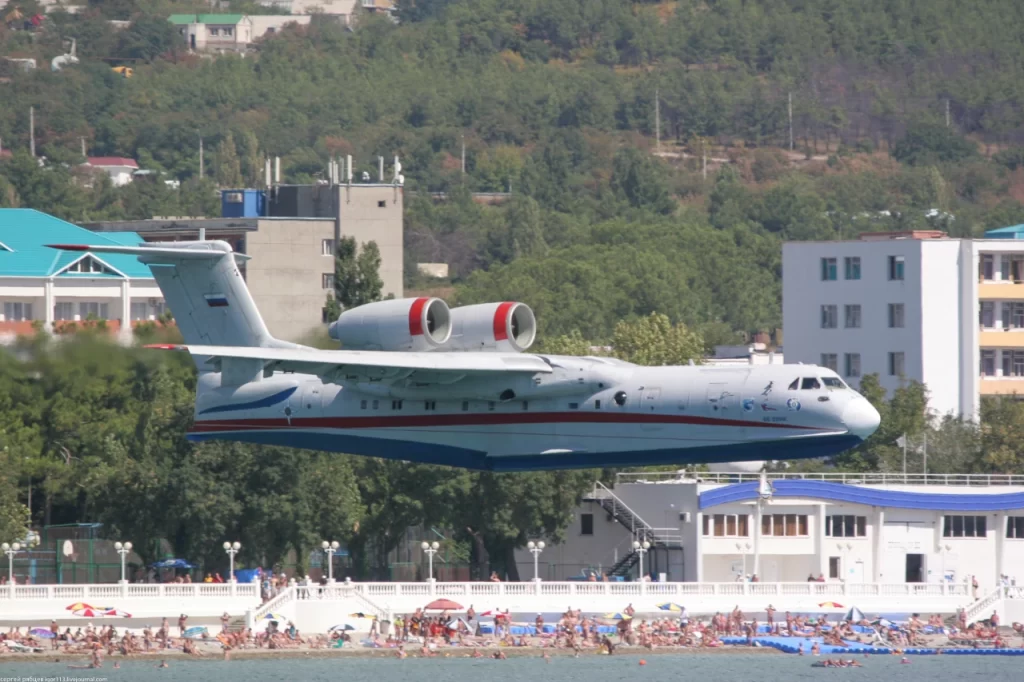The A-40 “Albatross,” once regarded as the largest in its category anywhere in the world, will again be built according to a decision by the Russian Ministry of Defence. The publication “Izvestia,” which cites anonymous sources from the Russian defence sector and the aviation industry, reports that the aircraft will be modernised as part of the project’s revitalisation. It is intended that the A-40 will serve dual roles as an anti-submarine aircraft and a search and rescue aircraft.
In its military format, the “Albatross” can transport up to 6.5 tonnes of various types of armament. This can comprise three “Orlan” torpedoes, four “Korshun” torpedoes, four “Yastreb” anti-submarine missiles, six “Orel” torpedoes, or six “Yastreb” anti-submarine missiles. If the situation calls for it, the A-40 can perform the duties of a torpedo bomber or a missile carrier. Additionally, it can be used for placing depth charges, acoustic buoys, and even sea mines.
The Taganrog Beriyev Aviation Scientific-Technical Complex developed the A-40 between the late 1980s and the early 1990s. It was initially designated as the Be-42. The aircraft project was terminated in 1993 because the Russian Ministry of Defence did not have sufficient financing or interest in the endeavour.
The aircraft’s basic configuration boasted impressive characteristics for a jet amphibious aircraft. The “Albatross” had a crew of four to eight persons, and its dimensions were 45.7 x 42.5 x 11.07 metres, with a wing area of 200 square metres. Maximum takeoff weight was 90 tonnes, with 10 tonnes of payload. The A-40’s takeoff thrust was provided by a pair of RD-60K turbojet engines, while a pair of D-30TKPV engines provided its flight thrust. In surface mode, the aircraft could withstand surges up to 2.2 metres in height. 13 kilometres was the utmost flight altitude. The flight range was approximately 5,000 kilometres, and the maximum loiter duration was 12 hours. At altitude, the A-40’s cruise and top velocities are 720 and 800 kilometres per hour, respectively.
The seaplane’s hull consisted of three major sections. The forward hermetic section had cockpits and workstations for six crew members, including the pilots and operators. Due to the long duration of the flight, this section included a toilet, a wardrobe, and a rest area for the personnel. In the non-airtight portion of the hull were technical compartments containing mission systems and onboard equipment, as well as a cargo compartment containing deployable ordnance (radio-hydroacoustic buoys, anti-submarine torpedoes, depth charges, mines, and missiles) and, if necessary, aviation rescue containers.
According to “Izvestia,” the A-40 amphibious aircraft project’s coordination phase is underway. The military is simultaneously developing the tactical and technical requirements for modernised amphibious aircraft. If all coordination phases are successful, the Russian Ministry of Defence will acquire three new A-40 aircraft. As part of the revived project, the A-40 is anticipated to receive updated onboard equipment and submarine detection systems. Other project details are currently not specified.

In the past, the Russian Ministry of Defence tried to bring the project back to life. In 2008, the military wanted to relaunch the construction of the “Albatross” as a universal transport, search and rescue, and anti-submarine aircraft. In 2012, the military announced that the A-40 project would no longer be continued. In 2016, it was intended for all Be-12 anti-submarine aircraft to be replaced with A-40 amphibious aircraft by 2020.
The Chinese AG600, which has been in development since the early 2010s, has the title of the world’s largest amphibious aircraft. Test flights with this aircraft are now being carried out. The Chinese amphibious aircraft has dimensions of 37 metres in length and 38.8 metres across the span of its wings. The maximum takeoff weight is known to be 53.5 tonnes. The amphibious aircraft has a maximum speed of 570 kilometres per hour and flies up to 5,000 km in a single flight. It can carry up to 50 passengers.
At the end of July 2019, Admiral Valentin Selivanov, Chief of the General Staff of the Russian Navy, announced that the anti-submarine amphibious aircraft Be-12 had begun modernisation. Some aircraft have already been outfitted with newly installed onboard radio-electronic equipment, hydroacoustic systems, magnetic anomaly detectors, and weapons as part of the ongoing work. This work is currently in progress. The Be-12 aircraft in the Russian naval aviation fleet have the longest service history.
The Be-12 is 30.1 metres long and has a wing span of 30.2 metres. The plane’s top speed is 550 kilometres per hour and it can travel about 1000 kilometres. The total weight of the anti-submarine armaments the “Chaika” (Seagull) can carry is 1.5 tonnes. Until 1973, 143 Be-12s were produced. The Russian Navy’s aviation fleet currently consists of only nine Be-12 planes.
